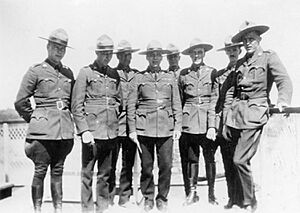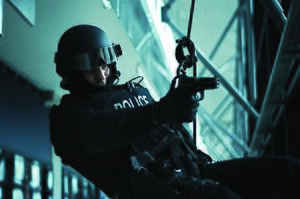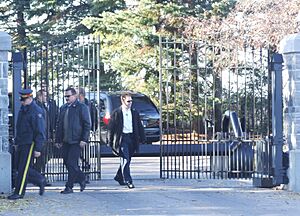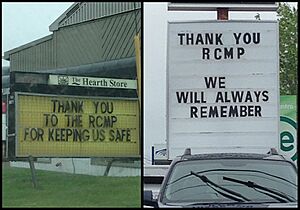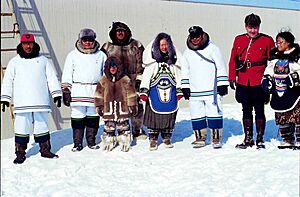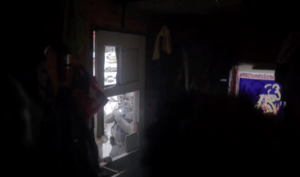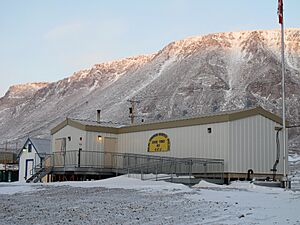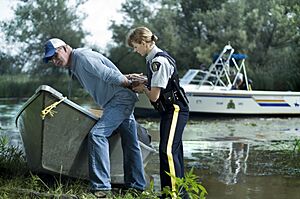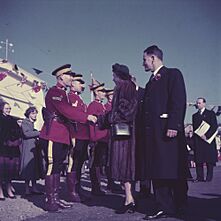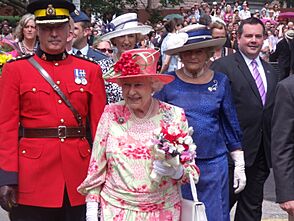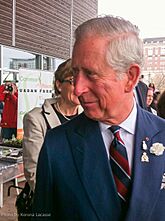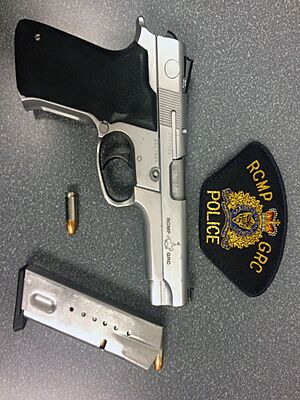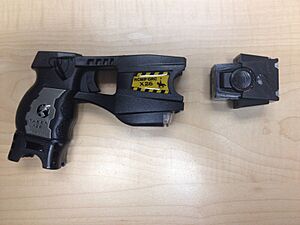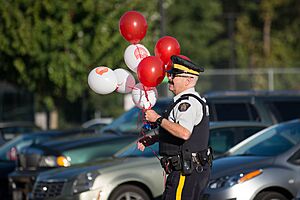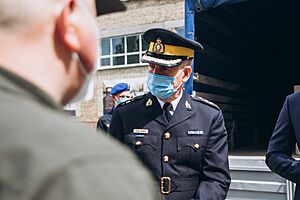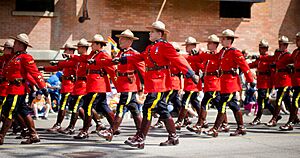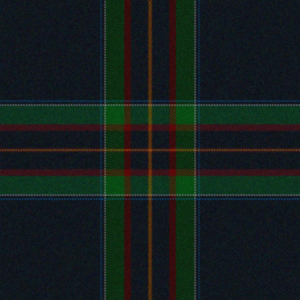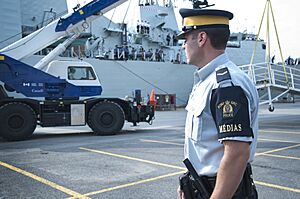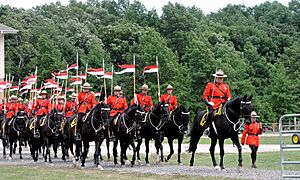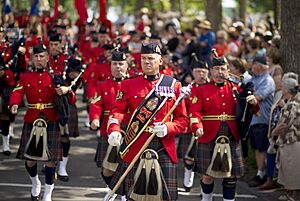Royal Canadian Mounted Police facts for kids
Quick facts for kids Royal Canadian Mounted PoliceGendarmerie royale du Canada |
|
|---|---|
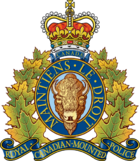
Badge of the RCMP
|
|

Patch (i.e. shoulder flash) of the RCMP
|
|

Corps ensign of the RCMP
|
|
| Common name | The Mounties |
| Abbreviation |
|
| Motto | Maintiens le droit (French for 'uphold the right' / 'maintain the right' / 'defend the law') |
| Agency overview | |
| Formed | May 23, 1873 (NWMP formed) February 1, 1920 (renamed to RCMP and absorption of Dominion Police) |
| Preceding agencies |
|
| Employees | 40,000+ (2025) |
| Volunteers | Approximately 3,000+ auxiliary (2025) constables |
| Jurisdictional structure | |
| Federal agency | Canada |
| Operations jurisdiction | Canada |
| Constituting instruments |
|
| General nature | |
| Operational structure | |
| Headquarters | M. J. Nadon Government of Canada Building 73 Leikin Drive Ottawa, Ontario K1A 0R2 |
| Sworn members |
22,445 (April 2021)
|
| Unsworn members |
5,759 (April 2021)
|
| Minister responsible |
|
| Agency executive |
|
| Parent agency | Public Safety Canada |
| Divisions |
15
National Division: National Capital Region
B Division: Newfoundland and Labrador C Division: Quebec D Division: Manitoba E Division: British Columbia F Division: Saskatchewan G Division: Northwest Territories H Division: Nova Scotia J Division: New Brunswick K Division: Alberta L Division: Prince Edward Island M Division: Yukon O Division: Ontario V Division: Nunavut Depot Division: Regina, Saskatchewan; Innisfail, Alberta |
| Detachments |
712
BC/BCE: 154 |
| Facilities | |
| Vehicles |
8,677
Cars: 5,600
Trucks: 2,350 Motorcycles: 34 Snowmobiles: 481 All-terrain vehicles: 181 Armored Personnel Carriers: 2 |
| Boats | 5 |
| Fixed-wings | 26 |
| Helicopters | 9 |
| Notables | |
| Significant incidents |
|
| Awards |
|
| While a federal agency, the RCMP also serves as the local law enforcement agency for various provincial, municipal, and First Nations jurisdictions. | |
The Royal Canadian Mounted Police (RCMP), also known as the Mounties, is Canada's national police force. It is a part of the Government of Canada. The RCMP helps enforce laws across Canada. They also provide police services to many provinces, territories, cities, and Indigenous communities.
The RCMP was formed in 1920. It combined two older police groups: the Royal North-West Mounted Police and the Dominion Police. RCMP officers have the power to act as police officers in all parts of Canada. They enforce federal laws, investigate crimes that cross provinces or countries, and help with border security. They also help with Canadian peacekeeping missions and manage the Canadian Firearms Program.
Even though they are called "Mounted Police," the RCMP mostly uses vehicles today. Horses are mainly used for special events and ceremonies. The Canadian government sees the RCMP as an important national symbol. Many Canadians feel the RCMP is a key part of their country's identity.
Contents
History of the RCMP
Early Years (1920–1970)
The Royal Canadian Mounted Police started in 1920. It was created by joining two police forces: the Royal North-West Mounted Police (RNWMP) and the Dominion Police. The RNWMP had policed the Canadian West. The Dominion Police handled federal law enforcement and security. The new RCMP kept the strong, disciplined style of the RNWMP.
In 1928, the government allowed the RCMP to work with provinces and cities. This meant the RCMP could help with local policing again. The federal government paid most of the costs. By 1950, many provinces chose the RCMP to be their police force.
The RCMP also gathered information on certain groups in Canada. This included political groups and some Indigenous and minority communities. They also helped with immigration matters. For example, they were involved in deporting some people.
In 1932, RCMP officers were part of a famous chase involving Albert Johnson, known as the "Mad Trapper of Rat River." Johnson had caused problems for local trappers. When officers tried to arrest him, he shot one.
In 1935, the RCMP was involved in the Regina Riot. This happened when they tried to stop a protest march heading to Ottawa. One city police officer and one protester died. The event had a big impact on Canadian politics.
During the 1930s, the RCMP sometimes helped during worker disputes. In 1940, the RCMP ship St. Roch made history. It was the first ship to sail through the Northwest Passage from west to east. It also sailed the passage in one season and circled North America.
In 1941, two Black Canadian men from Nova Scotia tried to join the RCMP. They passed the tests, but were not hired. In 1969, Hartley Gosline became the first Black police officer hired by the RCMP.
After World War II, the RCMP's intelligence work grew. In 1950, they created a special branch for security and intelligence. In 1953, the RCMP joined Interpol.
Later 20th Century History
In 1973, Queen Elizabeth II approved a new badge for the RCMP. In 1978, the RCMP created emergency response teams. These teams handle serious situations that need special police tactics.
In 1986, after some serious attacks, the government asked the RCMP to form a full-time counter-terrorism unit. This unit was called the Special Emergency Response Team (SERT). In 1993, the SERT was moved to the Canadian Forces and became Joint Task Force 2 (JTF2).
In 1995, the Personal Protection Group (PPG) was created. This group protects important people like the prime minister and the governor general.
RCMP Security Service (1950–1984)
The RCMP Security Service (RCMPSS) was a special branch that handled national security. In the late 1970s, it was revealed that the RCMPSS had done some illegal things. Because of this, the RCMPSS was replaced by a new, separate agency called the Canadian Security Intelligence Service (CSIS) in 1984. The RCMP and CSIS still work together on some law enforcement tasks, especially related to anti-terrorism.
21st Century History
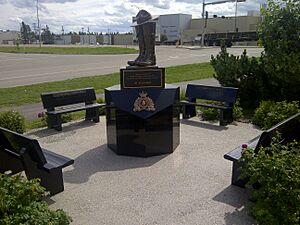
After the September 11 attacks, the RCMP started the Sky Marshals program in 2002. These officers work to keep passenger aircraft safe.
In March 2005, four RCMP officers were killed in the Mayerthorpe tragedy in Alberta. This was a very sad event for the RCMP. As a result, officers were later given C8 rifles to help them deal with dangerous situations.
In 2006, the RCMP and the United States Coast Guard started a program called "Shiprider." This allows officers from both countries to work together on vessels to enforce laws across the border.
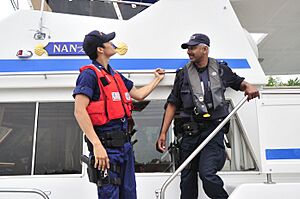
In 2006, RCMP Commissioner Giuliano Zaccardelli resigned after issues arose regarding the Maher Arar case. This led to changes to make the RCMP more accountable. In 2007, the RCMP was named "Newsmaker of the Year" by The Canadian Press.
2010s Events
In May 2012, the RCMP mounted the Queen's Life Guard in London for Queen Elizabeth II's Diamond Jubilee. In June 2013, the RCMP's "A Division" became the "National Division." It now focuses on corruption cases.
In June 2014, three RCMP officers were killed during the Moncton shooting. This led to a review of RCMP safety procedures. The RCMP was later charged for not giving officers C8 carbines fast enough.
In October 2016, the RCMP apologized for harassment and discrimination against female officers. They also set up a fund to help these victims.
In January 2019, the RCMP enforced a court order against the Wet’suwet’en First Nation. This led to protests across Canada.
2020s Events
In February 2020, the RCMP again enforced the court order, leading to more arrests and protests. There was criticism about the RCMP's tactics. Two journalists were arrested, leading to a government investigation.
On March 10, 2020, Chief Allan Adam of the Athabasca Chipewyan First Nation was arrested by RCMP officers. A video of the arrest caused concern. Prime Minister Justin Trudeau and RCMP Commissioner Brenda Lucki later stated that systemic racism exists in the RCMP.
RCMP Constable Heidi Stevenson was killed while responding to the 2020 Nova Scotia attacks in April 2020. The RCMP faced strong criticism for its response to these attacks.
In June 2021, the Privacy Commissioner of Canada found that the RCMP had broken privacy laws by using Clearview AI. In February 2022, four men were arrested in Alberta for an alleged plan to harm RCMP officers.
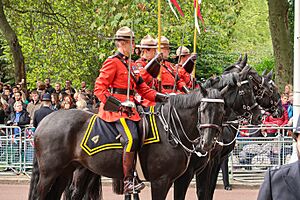
On September 19, 2022, RCMP members led the procession at the state funeral for Queen Elizabeth II in London, England.
In 2023, a commission recommended changes to RCMP training. It also suggested reviewing the RCMP's role in contract policing. The RCMP started a new training program for federal policing candidates.
Recently, the cities of Surrey, British Columbia and Grande Prairie, Alberta, decided to create their own police forces instead of using the RCMP. Other areas are also considering similar changes.
RCMP's Role in Canadian History
The RCMP has played a big and sometimes debated role in the colonization of Canada. The RNWMP, the RCMP's earlier form, had a complex relationship with Indigenous peoples in Canada. While they sometimes helped restore order, they often did not provide the same police services to Indigenous communities as they did to non-Indigenous ones.
Historians have compared the RCMP to the Texas Rangers. Both groups protected the existing order, controlled Indigenous and mixed-blood peoples, and helped large landowners.
From 1920 to 1996, RCMP officers acted as truant officers for Indian residential schools. They helped bring children to these schools, sometimes by force. Records show the RCMP believed they were protecting children. However, abuses within the residential school system were often not reported to the RCMP at the time.
The RCMP also played a role in land disputes.
Role in Land Disputes
In 1995, the RCMP was involved in the Gustafsen Lake standoff. This was a dispute over land. The RCMP used many officers and vehicles, which caused international debate.
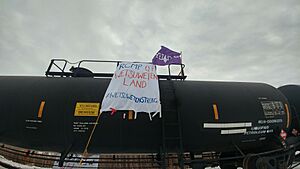
Between 2019 and 2020, the RCMP spent a lot of money policing protests against a pipeline on Wet'suwet'en territory. The RCMP's actions in enforcing court orders led to international protests.
Women in the RCMP
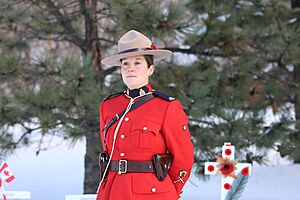
In the 1920s, Frances Gertrude McGill, a pathologist, helped the RCMP with forensic science. She helped create the first RCMP forensic lab in 1937.
On May 23, 1974, the RCMP announced that women could become regular members. The first group of 32 women started training in September 1974 and graduated in March 1975.
At first, female officers wore different uniforms. Now, all officers wear the same uniform, with a few small differences for formal events or maternity wear.
Over the years, women have achieved many important positions in the RCMP:
- 1981: First female corporal in the Musical Ride.
- 1987: First female officer in a foreign post.
- 1990: First female detachment commander.
- 1992: First female commissioned officer.
- 1998: First female assistant commissioner.
- 2000: First female deputy commissioner.
- 2006: First interim female commissioner.
- 2018: First permanent female commissioner.
How the RCMP is Organized
National Structure
The RCMP is set up under the Royal Canadian Mounted Police Act. This law says the RCMP is Canada's federal police force. It can also provide police services to provinces and cities if they ask for it.
The head of the RCMP is called the Commissioner. The Commissioner manages the force under the direction of the Minister of Public Safety. The RCMP also has a Senior Executive Committee that makes important decisions.
Divisions
The RCMP divides Canada into different areas called divisions for command. Each division usually covers a province. For example, "C Division" is in Quebec. Ontario has two divisions: National Division (for the capital region) and O Division (for the rest of the province). There is also Depot Division, which is where the RCMP Academy is located in Regina. The main RCMP headquarters are in Ottawa, Ontario.
| Division | Location | Year established | Headquarters |
|---|---|---|---|
| National (formerly A) | National Capital Region | 1874 | Ottawa |
| Depot | Regina | 1885 | Regina |
| B | Newfoundland and Labrador | 1949 | St. John's |
| C | Quebec | 1874 | Montreal |
| D | Manitoba | 1874 | Winnipeg |
| E | British Columbia | 1874 | Surrey |
| F | Saskatchewan | 1874 | Regina |
| G | Northwest Territories | 1885 | Yellowknife |
| H | Nova Scotia | 1885 | Halifax |
| J | New Brunswick | 1932 | Fredericton |
| K | Alberta | 1885 | Edmonton |
| L | Prince Edward Island | 1932 | Charlottetown |
| M | Yukon | 1904 | Whitehorse |
| O | Ontario | 1920 | Toronto |
| V | Nunavut | 1999 | Iqaluit |
Detachments
A detachment is a local RCMP office that polices a specific area. Detachments can be very different in size. The largest RCMP detachment is in Burnaby, British Columbia. Smaller detachments in rural areas might have only a few officers. In 2012, the RCMP decided that detachments should have at least three officers.
Personal Protection Group

The Personal Protection Group (PPG) is a team of 180 members. They are in charge of keeping important people safe. This includes the King, other members of the Royal Family, the governor general of Canada, and the prime minister of Canada. They also protect other important people like judges and diplomats.
International Work
The RCMP also works internationally to stop crime that affects Canada. They have officers in 23 other countries. These officers help with investigations, share information, and represent the RCMP at international meetings.
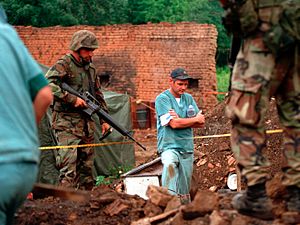
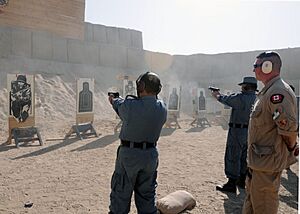
The RCMP also helps train police officers in other countries, like in Iraq. They have also helped the Haitian National Police since 1994.
RCMP Personnel
As of April 2019, the RCMP had over 30,000 people working for them. This includes police officers, civilian members, and public service employees.
RCMP officers are paid based on their rank and how long they have served. A new constable starts at about $71,191 per year. Their salary increases as they gain more experience.
Regular Members
"Regular members" are the trained and sworn police officers of the RCMP. They investigate crimes and make arrests. They work in over 750 detachments across Canada. Regular members usually start with general policing duties for at least three years. This gives them experience in many areas, like responding to emergency calls, traffic enforcement, and collecting evidence. They can also work in specialized areas like major crime investigations, emergency response, or police dog services.
Other Staff Members
Besides regular officers, the RCMP has other types of staff with different roles:
- Community Constables (CC): These are armed, paid members who help connect the RCMP with local citizens. They focus on crime prevention and community relations.
- Reserve Constables (R/Cst.): These are retired RCMP members or other trained officers who can work part-time. They help when more staff are needed and have the same powers as regular members when on duty.
- Auxiliary Constables (A/Cst.): These are volunteers who help regular members with tasks like crowd control or community policing. They are not police officers but have some powers when working with a regular member.
- Special Constables (S/Cst.): These employees have special skills or knowledge. For example, an Indigenous person might be a special constable to help officers in an Indigenous community where English is not the main language. Many RCMP aircraft pilots are also special constables.
- Civilian Criminal Investigators (CCI): These are unarmed staff members who work on specialized investigations, often in computer science or finance. They help with interviews and court documents.
- Civilian Members: These people are hired for their special skills in science, technology, communications, or administration. They support the RCMP's work but are not police officers.
- Public Service Employees: These employees provide administrative support for the RCMP. They are not police officers and do not wear uniforms.
- Municipal Employees: These are employees hired by local cities to work in RCMP detachments. They do administrative tasks similar to public service employees.
Ranks
The RCMP has a rank system similar to the military. It has commissioned officers (higher ranks) and non-commissioned officers (lower ranks). The ranks show a person's position and responsibility within the force.
| Commissioned Officers | |||||
|---|---|---|---|---|---|
| Commissioner | Deputy Commissioner | Assistant Commissioner | Chief Superintendent | Superintendent | Inspector |
| Commissaire | Sous-commissaire | Commissaire adjoint | Surintendant principal | Surintendant | Inspecteur |
| Commr. | D/Commr. | A/Commr. | C/Supt. | Supt. | Insp. |
| 1 | 6 | 33 | 55 | 186 | 331 |
| Non-Commissioned Officers | Constables | Depot | |||||
|---|---|---|---|---|---|---|---|
| Corps Sergeant Major | Sergeant Major | Staff Sergeant Major | Staff Sergeant | Sergeant | Corporal | Constable | Cadet |
| Sergent-major du corps | Sergent-major | Sergent-major d'état major | Sergent d'état-major | Sergent | Caporal | Gendarme | Cadet |
| C/S/M. | S/M. | S/S/M. | S/Sgt. | Sgt. | Cpl. | Cst. | Cdt. |
| 1 | 8 | 10 | 828 | 2,037 | 3,565 | 11,859 | Varies |
| No Insignia | |||||||
The higher ranks are appointed by the government. Lower ranks have badges on their sleeves. Constables do not wear rank insignia. The RCMP also has special constables, reserve constables, auxiliary constables, and students who wear identifying badges.
The star, or "pip," on officer uniforms represents a military honour. The crown on senior officers' uniforms is a royal symbol. In 1968, the shoulder title changed to "GRC-RCMP" to include both French and English names.
Honorary Positions and the Royal Family
Members of the Canadian royal family hold honorary titles in the RCMP. These roles are similar to honorary positions in the Canadian Army. They help promote the RCMP's identity and history. They also visit operational units. The Commissioner-in-Chief advises the force but does not have an operational role.
All RCMP members swear allegiance to the Monarch of Canada, currently Charles III.
Commissioner-in-Chief
The Commissioner-in-Chief is the highest honorary position in the RCMP. It is held by Charles III, King of Canada. He received this role before his coronation in 2023.
This role was created in 2012 to show the close link between the Canadian monarch and the RCMP. The Commissioner-in-Chief receives updates on RCMP activities. They also promote the Mounted Police in Canada and other countries.
Honorary Deputy Commissioner
Honorary Deputy Commissioners are honorary positions for senior members of the Canadian Royal Family. Their role also shows the connection between the Royal Family and the RCMP.
The current honorary deputy commissioners are Anne, Princess Royal and Prince Edward, Duke of Edinburgh.
Equipment and Vehicles
Land Fleet
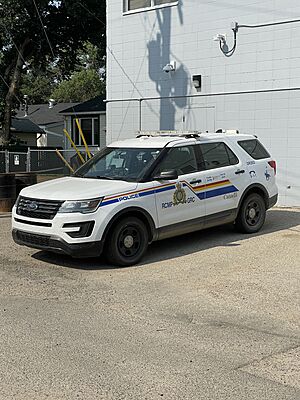
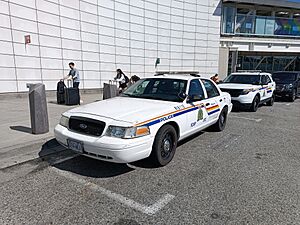
The RCMP uses many different vehicles on land. Their fleet includes:
- Cars: 5,330
- Unmarked vehicles: 2,811
- Light trucks: 2,090
- Heavy trucks: 123
- SUVs: 616
- Motorcycles: 34
- Small snowmobiles: 481
- All-terrain vehicles: 181
- Tractors: 27
- Buses: 3
- Armoured Personnel Carriers: 2
- Total: 11,699
Marine Craft

The RCMP patrols Canada's waters, including lakes, rivers, and coastal areas. They enforce laws related to the environment, fishing, customs, and immigration.
The RCMP has a Marine Division with five high-speed patrol vessels. These boats are used on all three coasts. The RCMP also operates 377 smaller boats across Canada. These range from canoes to rigid-hulled inflatable boats.
Aircraft Fleet
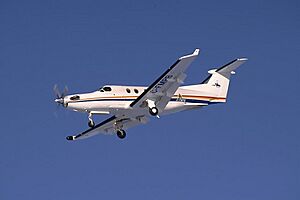
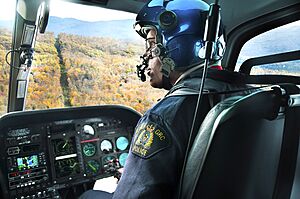
As of February 2023, the RCMP has 35 police aircraft. This includes 9 helicopters and 26 fixed-wing aircraft. The Air Services Branch operates and maintains all aircraft.
| Aircraft | Number | Variants | Notes |
|---|---|---|---|
| Aerospatiale AS350 Écureuil | 6 | AS 350B3 | Helicopter, AStar 350 or "Squirrel" |
| Airbus H145 | 1 | H145 | Helicopter, light twin-engine, four-axis autopilot. Serving the Lower Mainland of BC ("E" Division) |
| Cessna 206 | 5 | U206G, T206H | Fixed wing, Stationair (station wagon of the air), general aviation aircraft |
| Cessna 208 Caravan | 3 | 208, 208B | Fixed wing, caravan, short-haul regional airliner and utility aircraft |
| de Havilland Canada DHC-6 Twin Otter | 1 | 300 Series | Fixed wing, 20-passenger STOL feederliner and utility aircraft, twin-engine. |
| Eurocopter EC120 Colibri | 2 | EC 120B | Light helicopter, "Hummingbird" |
| Pilatus PC-12 | 15 | PC-12/45, PC-12/47, PC-12/47E | Fixed wing, turboprop passenger and cargo aircraft |
| Quest Kodiak | 1 | 100 | Fixed-wing, un-pressurized, turboprop-powered fixed-tricycle-gear, STOL |
| Sikorsky UH-60 | 2 | UH-60A | Utility helicopter leased from Helicopter Transport Services Canada (C-FHLY and C-FHKS); ex US Army 1981/1985 |
Weapons and Tools
RCMP officers use various tools and weapons to do their job safely and effectively. These include:
- Smith & Wesson Model 5946 (since 1992) – Standard service pistol.
- Smith & Wesson Model 3953 (since 1996) – Smaller pistol for plainclothes officers.
- SIG Sauer 226R – Used by emergency response teams and dog handlers.
- Glock Model 19 – Used by Sky Marshals.
- Heckler & Koch MP5 – Used by emergency response teams.
- Remington Model 700 rifle.
- Remington 870 shotgun.
- Colt Canada C7 rifle and C8 carbine – Used by officers, with the C8 carbine becoming more common after 2011.
- Taser International M26, X26, and X26P – Used as conducted energy weapons.
- Oleoresin capsicum spray.
- ASP and Monadnock expandable batons.
Uniforms
Operational Uniform
RCMP officers on duty wear grey shirts with RCMP badges on the shoulders. They wear navy blue pants with a gold stripe. They also wear bulletproof vests and a peaked cap. High-ranking officers wear white shirts. In cold weather, they might wear winter coats or fur caps.
Since 1990, Sikh officers have been allowed to wear a turban instead of the traditional hat. As of 2019, all RCMP officers can wear full beards or braided hair. Officers can also wear a ballcap instead of the peaked cap.
Dress Uniform
For formal duties, RCMP officers wear a "blue serge" dress uniform. It includes a navy blue jacket with brass buttons, a white shirt, a navy blue tie, and navy blue pants with gold stripes. They also wear a peaked cap.
Ceremonial Uniform
For most formal and ceremonial events, the RCMP wears the famous Red Serge. This uniform has a bright red tunic, dark blue pants with yellow stripes, and shiny oxblood riding boots. They also wear a brown felt hat with a special shape and matching gloves. Since 1990, both men and women wear the same ceremonial uniform.
Decorations
RCMP members receive special clasps and stars for every five years of service. The King of Canada also awards the Royal Canadian Mounted Police Long Service Medal for 20 years of service. Officers can also earn badges for being good at pistol or rifle shooting.
Tartan
Since 1998, the RCMP has had its own special tartan. This tartan was approved by Commissioner Phillip Murray and registered with the Scottish Tartans Society. Anne, Princess Royal presented it to the RCMP in 1998.
Military Status
|
|
|---|---|
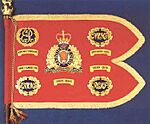
1973–2023 guidon of the RCMP
|
|
| Active | 1873–present |
| Country | Canada |
| Type | Dragoons |
| Battle honours | see Battle honours |
| Commanders | |
| Commissioner-in-chief | King Charles III |
| Commissioner | Michael Duheme |
| Honorary deputy commissioners | The Duke of Edinburgh The Princess Royal |
| Insignia | |
| Tartan | RCMP |
| Abbreviation | RCMP/GRC |
Even though the RCMP is a civilian police force, in 1921, King George V gave it the status of a regiment of dragoons. This allowed the RCMP to display special honours it had earned.
Service in Wartime
The RCMP's earlier force, the North-West Mounted Police, was involved in battles during the North-West Resistance in 1885. Members also served in the Second Boer War. For their service, King Edward VII changed the name to "Royal Northwest Mounted Police" in 1904.
During the First World War, RNWMP officers patrolled borders and helped with national security in Canada. Some also served overseas in France and Siberia.
In September 1939, at the start of the Second World War, the RCMP formed a company of volunteers to act as military police. They served throughout the war in Europe.
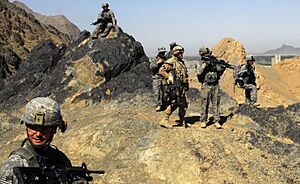
RCMP members also worked with military units in Afghanistan from 2001 to 2014.
Honours
The RCMP was given the status of a dragoon regiment in 1921. This meant they could carry a special flag called a guidon and display battle honours for their service in wars.
Battle Honours
- North West Canada 1885
- South Africa 1900–1902
- France & Flanders 1918
- Siberia 1918–19
- Second World War 1939–1945
- Afghanistan 2003–14
Public Perception
The Mounties are famous symbols of Canadian culture. They are often shown in movies and TV shows as strong, polite, and determined. The RCMP's motto is a French phrase, Maintiens le droit, which means "Uphold the right" or "Defend the law." The saying that they "always get their man" comes from an old report about two Mounties who captured whisky smugglers in 1877.
Contemporary Culture
In 1959, the Canadian Broadcasting Corporation aired R.C.M.P., a TV show about an RCMP detachment. The show was filmed near Ottawa.
Canadians also make jokes about the RCMP, like the character Sergeant Renfrew from the Royal Canadian Air Farce comedy group. The British TV show Monty Python's Flying Circus featured Mounties singing in "The Lumberjack Song." The TV series Due South showed a Mountie working with an American detective in Chicago.
In the early 1990s, Canadian professional wrestler Jacques Rougeau used the character "The Mountie." He wore the Red Serge to the ring. However, the RCMP stopped him from using this character in Canada due to trademark issues.
Merchandise and Trademarks
Many products and souvenirs feature the image of the RCMP, like statues or hats. Before 1995, the RCMP had little control over these products. Since April 1, 1995, the RCMP has an international license. This means companies must pay a fee to use the RCMP's name or image. The money from these fees helps fund community programs.
The RCMP Foundation manages the commercial use of the RCMP's name and image. They work with companies to create official RCMP merchandise.
Public Relations Programs
The RCMP has programs to build relationships with the public. One famous program is the Musical Ride. This is a show where RCMP riders perform equestrian skills across Canada each year. The RCMP Sunset Ceremony also takes place every summer in Ottawa.
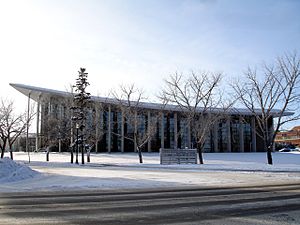
The RCMP Heritage Centre is a museum in Regina, Saskatchewan. It opened in 2007 and celebrates the RCMP's role in Canada's history.
Bands
There are eight regional RCMP pipe bands across Canada. They perform at parades, police ceremonies, and public events. The first of these bands started in Alberta in 1992.
Before 1994, the RCMP also had a central professional band called the Royal Canadian Mounted Police Band. It was considered one of the best bands in Canada. However, it was dissolved in 1994 due to government budget cuts.
See also
 In Spanish: Policía Montada del Canadá para niños
In Spanish: Policía Montada del Canadá para niños
- Civilian Review and Complaints Commission for the Royal Canadian Mounted Police
- List of Canadian organizations with royal patronage
- List of controversies involving the Royal Canadian Mounted Police
- Police brutality against Indigenous Canadians
- Canadian genocide of Indigenous peoples
- List of Royal Canadian Mint RCMP coins
- RCMP harassment policy


